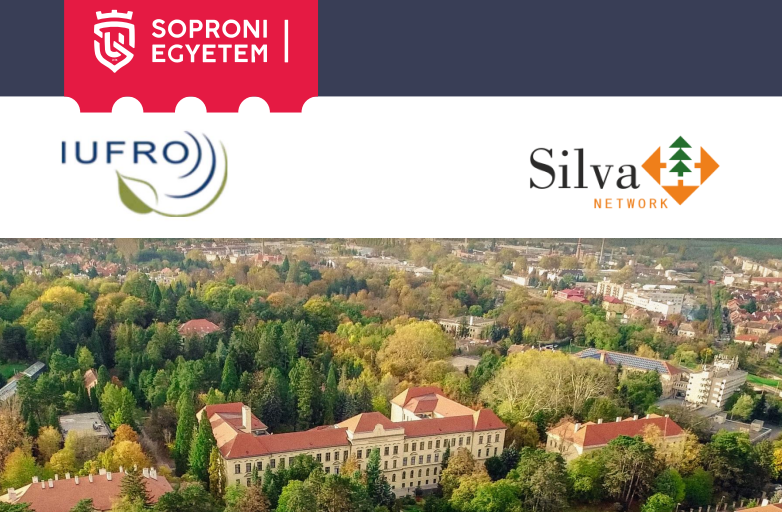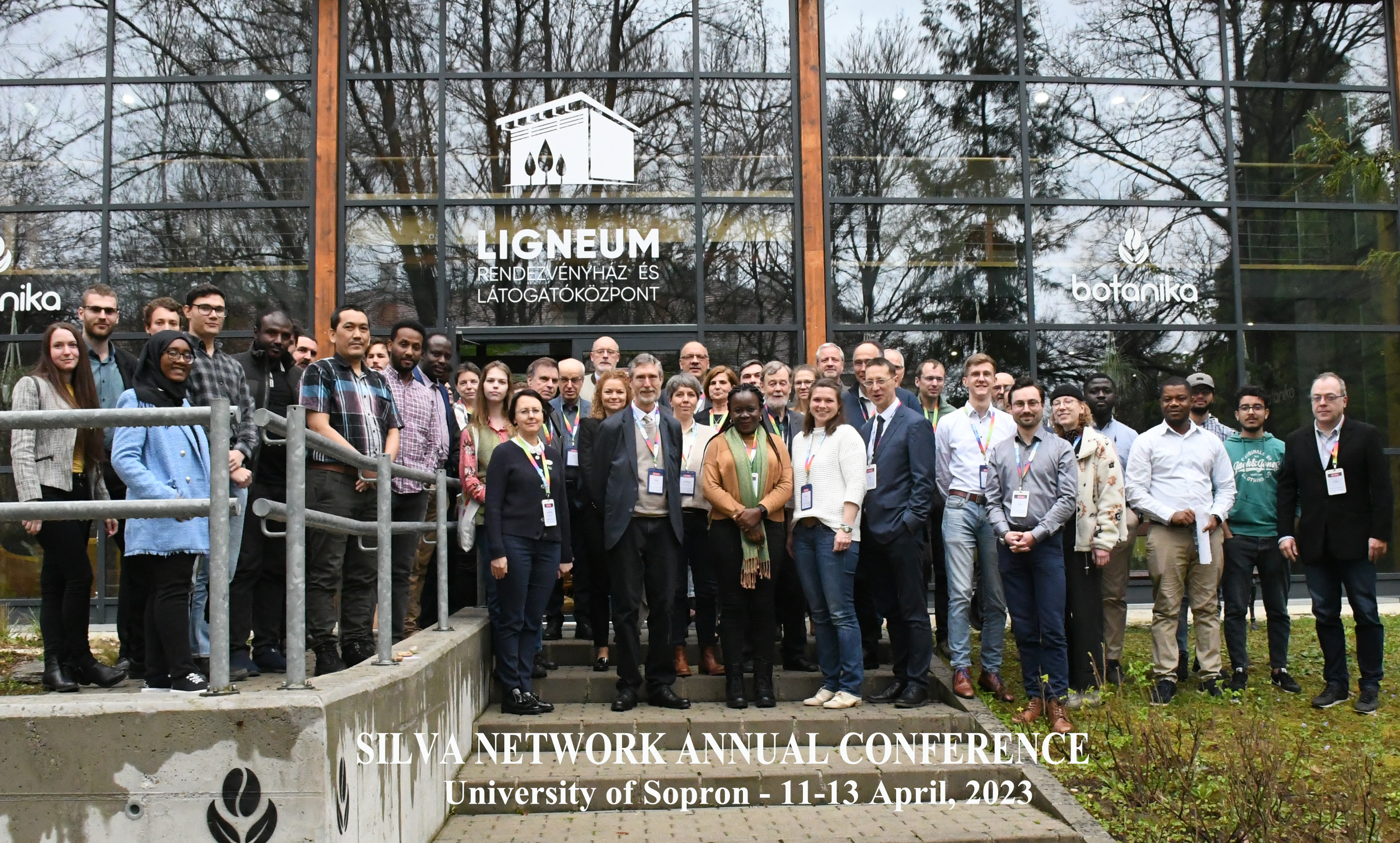
A konferenciát a Soproni Egyetem Erdőmérnöki Kara szervezi együttműködve a
Veszprémi Akadémiai Bizottság Erdészeti Szakbizottság Erdészettudományi Munkabizottságával

|
A több, mint ötven egyetemet magában foglaló hálózat, a Silva Network soproni konferenciájának témája a kommunikáció az erdészeti felsőoktatásban és továbbképzésben. Az üdvözlő beszédekben bemutatásra került a Soproni Egyetem Erdőmérnöki Karának szervezeti struktúrája és képzései, illetve a konferencia motorját képező Silva Network és az IUFRO szervezetek munkásságának ismertetésére is sor került. A délután folyamán több előadást is meghallgathattak a részvevők, amik főleg a kommunikáció fontosságát, stratégiai és metodikai megvalósítását, a felsőoktatásba történő beépítését és a projektek nyilvánosság elé hozatalát boncolgatták. Az első felvonásban az erdészeti és erdőtudományi kommunikációban történő egyetemi szerepvállalásról volt szó. Említésre kerültek az okos szenzorok terepi használatának kommunikációs kampányának gyakorlata, és a mesterséges intelligencia előnyei és hátrányai az oktatásban (Dr. Czimber Kornél), az erdőpedagógiai képzések bemutatása a Soproni Egyetemen (Dr. Tóth-Merza Katalin), konkrét kommunikációs példák Litvániából (Gediminas Brazaitis), illetve az új-zélandi fakitermelés és export jelentőségéről is meghallgathattak egy előadást az egybegyűltek (Robert I. Radics). Az előadások után különböző és változatos témák kutatóival való beszélgetésre nyílt lehetőség interaktív formában. A témák között bemutatásra került az agrárerdészet szerepe a növekvő fa iránti keresletben (Dr. Vityi Andrea), az erdei turisztikai látogatók létszámának alakulása a COVID időszakban és utána (Czibula György), az erdészeti felsőoktatásban elsajátítandó kommunikációs képességek (Ignazio J. Diaz-Maroto), és a társadalmi kommunikáció gyakorlata egy nemzeti park esetében (Sara Kitaibekova). A második napon a kommunikáció szintjei, tartalma és eszközei az erdészeti oktatásban és erdőgazdálkodásban került terítékre. Az első előadás folyamán (Sandra Liebal) a kommunikáció stratégiai fontosságába és gyakorlatába kaphattak betekintést a résztvevők, és említve lett még a multimédiás tartalmak előállítása, a célközönség meghatározása, a kommunikációs stílus megszabása, és az új, beszélgetésre és részvételre fókuszáló kommunikációs modell megszületése. A további előadások kitértek az erdő jelentőségére és a társadalomban és a kultúrában elfoglalt fontos szerepére, a közösségi média gyakorlatokra, a krízismenedzsmenttel kapcsolatos esettanulmányokra (Anne Austen), és az erdészeti képzéseknek a globalizációhoz történő adaptációs kérdéseire (Ignazio J. Diaz-Maroto). Az erdészeti ágazatban, és így annak kommunikációjában bekövetkezett paradigmaváltásról szóló előadásban napirendre kerültek olyan fontos témák, mint a kommunikációs platformok és eszközök változása, felgyorsulása, és a modern embernek a természettől való távolsága okán fontosnak tartott információközlés mikéntjének és részleteinek példái (Lomniczi Gergely). A konferencia harmadik részében a kommunikációs készségek iránti igény meghonosításáról volt szó az erdészeti oktatásban. A résztvevők erdélyi példákkal ismerkedhettek meg (Farkas Attila), betekintést kaphattak a fiatalok bevonásáról olyan szervezetek aktivitásaiba, mint a Forest Europe (Juliet Achieng Owuor), illetve a kommunikációs képességek fejlesztésének a tananyagba történő beépítésének írországi (Marie Doyle) és német (Dr. Stefanie Steinebach) példájából tanulhattak. Bemutatásra került a fenntarthatósági kommunikáció (Sara Kitaibekova), az erdészeti tevékenységek társadalmi megítélésének javítása (Konstantina Fotiadi, Anne Austen, Jesper Horst, Jacob Riedel), és az oktatók és hallgatók közötti kommunikáció fontossága (Kele Zsombor). A két napos konferencia lehetőséget adott az európai felsőoktatás szereplőinek értékes eszmecseréjére, gyümölcsöző kapcsolatainak további kialakítására, és a kommunikáció fontosságával kapcsolatban az egymás gyakorlati példáiból történő tanulásra is. |
The topic of the Sopron conference of the Silva Network, an organization of more than fifty universities, has been communication in higher forestry education and further education. In the welcome speeches, the organizational structure and the courses of the Faculty of Forestry of the University of Sopron were presented, as well as the work of the Silva Network and the IUFRO organizations, which have been the engines of the conference. During the afternoon, the participants could listen to several presentations which mainly discussed the importance of communication, its strategic and methodological implementation, and its integration into higher education. In the first session, the topic was the university's involvement in forestry and forest science communication. A practical example of the communication campaign of the use of smart sensors in the field and the advantages and disadvantages of artificial intelligence in education were presented (by Dr. Kornél Czimber), a presentation of the forest pedagogy training at the University of Sopron (by Dr. Katalin Tóth-Merza) was given, specific communication examples from Lithuania were mentioned (by Gediminas Brazaitis), and those gathered could also listen to a presentation about the importance of New Zealand logging and export (by Robert I. Radics). After the presentations, there was an opportunity to converse with researchers about different and diverse topics in an interactive format. Among the topics presented were the role of agroforestry in the growing demand for wood (by Dr. Andrea Vityi), the changes in the number of forest visitors during and after the COVID-19 period (by György Czibula), the communication skills to be acquired in higher forestry education (by Ignazio J. Diaz-Maroto), and the practice of social communication in the case of a national park (by Sara Kitaibekova). On the second day, the levels, content, and tools of communication in forestry education and forest management were discussed. During the first presentation (by Sandra Liebal), the participants were able to gain insight into the strategic importance and practices of communication, the creation of multimedia content, the definition of the target audience, the determination of the communication style. The birth of the new communication model focusing on conversation and participation has been also mentioned. The other presentations covered the importance of the forest and its significant role in society and culture, social media practices, case studies related to crisis management (by Anne Austen), and issues of adaptation of forestry training to globalization (by Ignazio J. Diaz-Maroto). In the presentation about the paradigm shift in the forestry sector, and thus in its communication, important topics such as the change and acceleration of communication platforms and tools, and examples of the how and the details of information communication (by Gergely Lomniczi) were on the agenda. The importance of communication was highlighted due to modern society’s distance from nature. The topic of the third part of the conference was the implementation of the need for communication skills in forestry education. The participants were able to learn about Transylvanian examples (by Attila Farkas), gain insight into the involvement of young people in the activities of organizations such as Forest Europe (by Juliet Achieng Owuor), and the integration of the development of communication skills into the curriculum in Ireland (by Marie Doyle) and in Germany (by Dr. Stefanie Steinebach). Sustainability of forest communication (by Sara Kitaibekova), improving the social perception of forestry activities (by Konstantina Fotiadi, Anne Austen, Jesper Horst, Jacob Riedel), and the importance of communication between university lecturers and students (by Kele Zsombor) were also presented at the conference. The two-day conference provided an opportunity for a valuable exchange of ideas between the representatives of European higher education, for the further development of fruitful relationships, and for learning from each other's practical examples regarding the importance of communication. |
| Title | Presenter |
| Registration from 11.00 a.m. at the Ligneum lobby | |
|
11th April, 2023; 2.00 p.m. |
|
| Welcome speech | Prof. Dr. Ferenc Lakatos, vice-rector for research and foreign affairs, UoS (Hungary) |
| Welcome speech | Péter Csóka, member of the board of trustees of the UoS (Hungary) |
| Introduction of forestry and forest education in Hungary ↓ | Dr. habil. Bálint Heil, dean of the Faculty of Forestry, UoS (Hungary) |
| Conference Opening ↓ | Prof. Dr. Norbert Weber, President SILVA Network & Chairman of Forest Policy and Forest Resource Economics, TU Dresden (Germany) |
| IUFRO Announcement | Mika Rekola, IUFRO Research Group 6.09 ”Forest Education” coordinator & Director, Master of Science programme, Forest Sciences, University of Helsinki (Finland) |
| Session I: The role of universities in forestry and forest science communication | |
| Forestry innovations, the best way facilitating communication outside of the forestry sector ↓ | Dr. habil. Kornél Czimber, vice-dean for research and foreign affairs, Faculty of Forestry, UoS (Hungary) |
| The pedagogical and psychological benefits of forest. The importance of connection and communication ↓ | Dr. Katalin Tóth-Merza and Dr. Éva Hartl, Benedek Elek Faculty of Pedagogy, and Dr. Tamás Horváth Faculty of Forestry UoS (Hungary) |
| Communication in modern world – the role of Faculty of Forest Science and Ecology in Lithuanian society ↓ | Gediminas Brazaitis, Vitas Marozas, Jolanta Stankevičiūtė, Faculty of forest science and ecology, Agricultural Academy Vytautas Magnus university (Lithuania) |
| Forestry education, communication and forestry’s public perception in New Zealand ↓ | Robert I. Radics, Lincoln University (New Zealand) |
| 12th April, 2023; 9.00 a.m. | |
| Session II: Levels, content and tools of communication in forestry education and forest management | |
| Paradigm shift in the communication of the Hungarian forestry sector ↓ | Gergely Lomniczi and Rudolf Merena, Indigo Communications Ltd. (Hungary) |
| Transforming scientific language into messages for the general public: Dissemination and communication of a European R&D project in the field of forestry ↓ | Sandra Liebal, Chair of Forest Policy and Forest Resource Economics, TU Dresden (Germany) |
| There will not always be light. Forestry risk and crisis communication needs innovative concepts to promote acceptance by society ↓ | Anne Austen, Chair of Forest Policy and Forest Resource Economics, TU Dresden (Germany) |
| Higher Education Globalisation: E-learning and Information & Communication Technologies ↓ | Ignazio J. Diaz-Maroto, Department of Agroforestry Engineering, University of Santiago de Compostela (Spain) |
| 12th April, 2023; 11.00 a.m. | |
| Session III - first part: How to implement the increasing need for communication skills in forestry education curricula | |
| The importance of communication as a discipline in the bachelor’s degree education of forestry in Romania and its legal limitations ↓ | Attila Farkas and Gábor Molnár, Sapientia Hungarian University of Transylvania (Romania) |
| Forest Europe´s work on Forest Education and Green jobs ↓ | Juliet Achieng Owuor, European Forest Institute, Bonn (Gemany) |
| 12th April, 2023; 1.30 p.m. | |
| Session III - seconf part: How to implement the increasing need for communication skills in forestry education curricula | |
| Building Communication Skills into a University Forestry Degree Programme | Marie Doyle, University College Dublin (Ireland) |
| The art of not being an “expert” – About the importance and content of communication training in higher forest education ↓ | Prof. Dr. Stefanie Steinebach, Professur Kommunikation und Waldpädagogik, University of Applied Forest Sciences Rottenburg (Germany) |
| Sustainability of forest communication and contribution for sustainable forestry in Kazakhstan: on the case of Seifullin University ↓ | Sara Kitaibekova, Saken Seifullin Kazakh Agrotechnical Research University (Kazakhstan) |
| Do good and talk about it! - But how? Communication as teaching term and value at the faculty of forestry in Tharandt, Germany ↓ | Konstantina Fotiadi, Anne Austen, Jesper Horst, Jacob Riedel, Students, TU Dresden (Germany) |
| Communication and relations between the students and teachers ↓ | Zsombor Kele, Student, Faculty of Forestry, UoS (Hungary) |
|
Poster session |
|
| Agroforestry can contribute to meeting the growing demand for wood ↓ | Andrea Vityi, Dániel Winkler, Katalin Tuba, Attila Benke, Attila Borovics, Géza Király, András Polgár, Andrea Vágvölgyi, UoS (Hungary) |
| Changes in the number of forest visitors in the Bakony region (Hungary) during and after the COVID-19 epidemic waves ↓ | György Czibula, PhD student, Faculty of Forestry, UoS (Hungary) |
| Communication skills in Higher Forestry Education as a key to perfect future engineers in the curricula ↓ | Ignazio J. Diaz-Maroto, Department of Agroforestry Engineering, University of Santiago de Compostela (Spain) |
| Assessement of recreation forestry through society communication: on the case of National Park ”Burabay” ↓ | Sara Kitaibekova, Saken Seifullin Kazakh Agrotechnical Research University (Kazakhstan) |
| Videos first day: 1 →, 2 → ; Videos second day: 3 →, 4 → | |
| Field trip - 13th April, 2023, morning at Ecucational Forestry Ltd ↓ | |



















































































